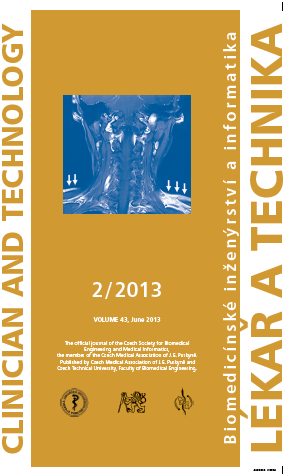INDIKACE K OPERAČNÍ LÉČBĚ POPÁLENIN PŘI VYUŽITÍ METODY LASERDOPPLER IMAGING
Keywords:
Laser Doppler Imaging (LDI), capillary perfusion, perfusion unit (PU), posttraumatic dayAbstract
The clinical assessment of depth of burns misdiagnosed in up to 35% of cases, especially in the early stages of thermal trauma to the 5th postoperative day. The correct determination of the depth of burns is crucial for planning the adequate therapeutic approach, ie, conservative or surgical treatment of burn wounds. Four basic grades of burn depth are distinguished cliniccaly. Grade I, IIa, IIb can be treated conservatively. Grade III and IV, but also some deeper grade IIb should be operated. Burns IIb cause the most diagnostic difficulties and the indications for surgical treatment is determind by depth of corium affection, which correlates with blood circulation in the dermis and the length of healing. Clinically, it is very difficult to estimate the depth of the affected dermis. LDI, laserdoppler imaging is the one of the ways to objectively and non-invasively assess the depth of the burns. LDI is an imaging technique that uses a laser radiation and the Doppler effect to detect blood flow in the skin capillaries. When thermal trauma directly damages the walls of capillaries, the subsequent tissue necrosis occures. Specificity and sensitivity of LDI in determining of the burn depth states 95% [1]. In our work, we propose a diagnostic algorithm for evaluation of capillary perfusion measured by LDI. Testing can be done up to 9th posttraumatic day, taking into account the current day after the accident. LDI is a suitable tool for the indication of surgical treatment. The following procedures should facilitate this process.Downloads
Published
Issue
Section
License
Copyright (c) 2017 Jiří Šťětinský, Hana Klosová, Zdenka Němečková Crkvenjaš, Hana Kolářová, Iveta Bryjová, Stanislav Hledík, Dana Šalounová

This work is licensed under a Creative Commons Attribution 4.0 International License.
Authors who publish with this journal agree to the following terms:
- Authors retain copyright and grant the journal right of the first publication with the work simultaneously licensed under a Creative Commons Attribution License (https://creativecommons.org/licenses/by/4.0/) that allows others to share the work with an acknowledgment of the work's authorship and initial publication in CTJ.
- Authors are able to enter into separate, additional contractual arrangements for the non-exclusive distribution of the journal’s published version of the work (e.g., post it to an institutional repository or publish it in a book), with an acknowledgment of its initial publication in this journal.
- Authors are permitted and encouraged to post their work online (e.g., in institutional repositories or on their website or ResearchGate) prior to and during the submission process, as it can lead to productive exchanges.
CTJ requires that all of the content of the manuscript has been created by its respective authors or that permission to use a copyrighted material has been obtained by the authors before submitting the manuscript to CTJ. CTJ requires that authors have not used any copyrighted material illegally, as for example a picture from another journal or book, a photo, etc. It is the author’s responsibility to use only materials not violating the copyright law. When in doubt, CTJ may ask the authors to supply the pertinent permission or agreement about the use of a copyrighted material.
The opinions expressed in CTJ articles are those of authors and do not necessarily reflect the views of the publishers or the Czech Society for Biomedical Engineering and Medical Informatics.


